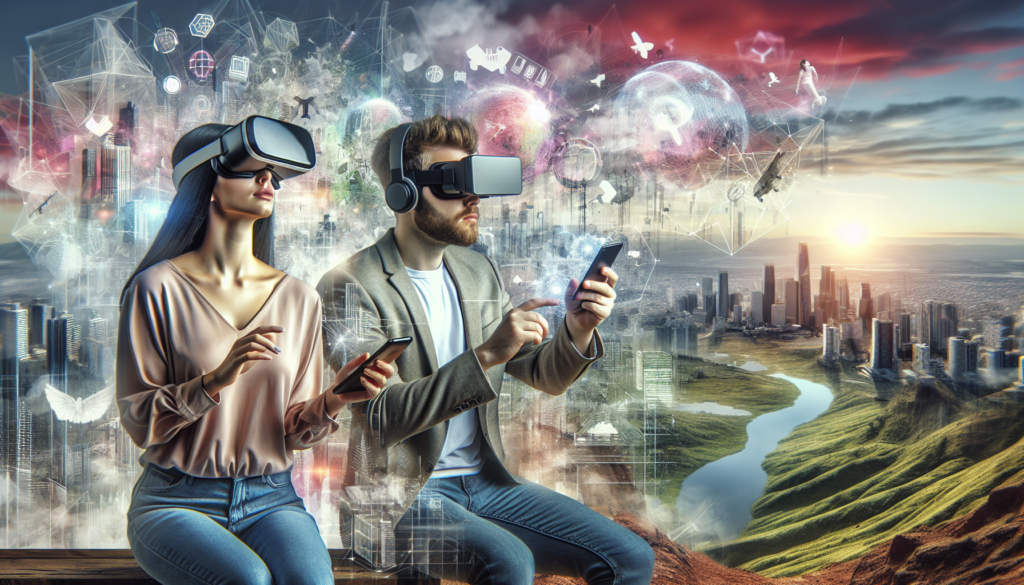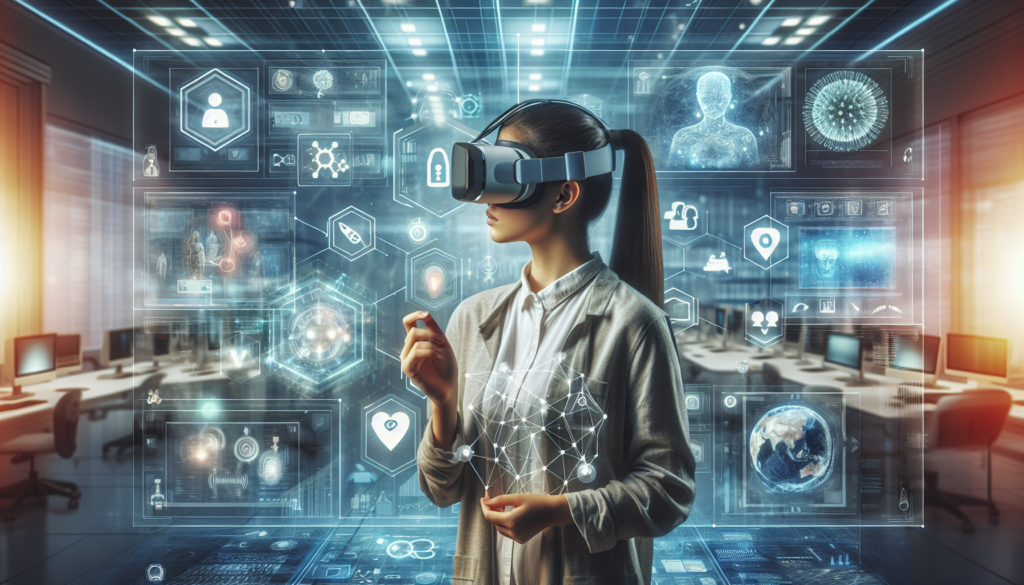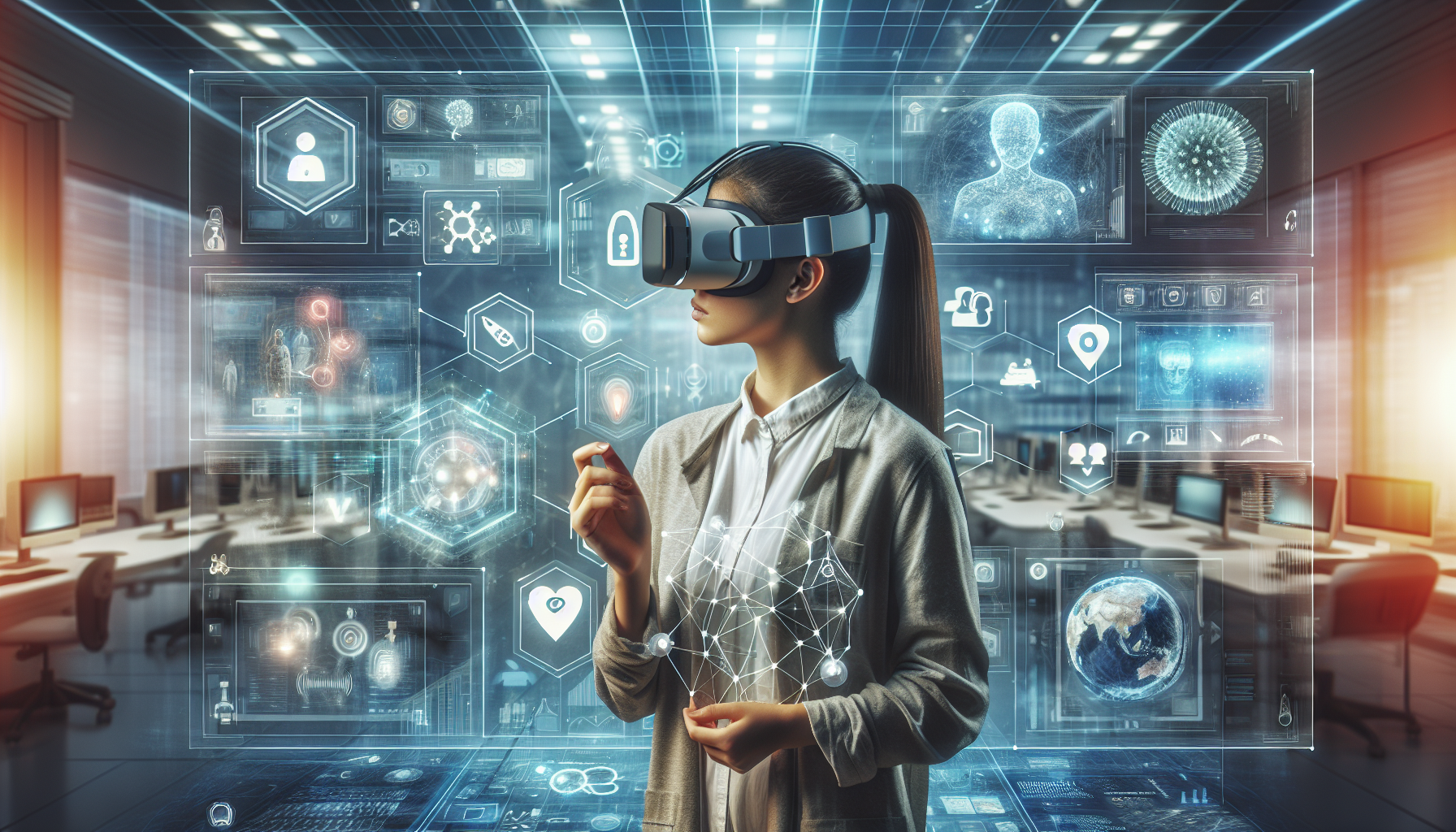Imagine stepping into a world where reality is enhanced and virtual environments come to life. That’s the promise of augmented reality (AR) and virtual reality (VR). Whether you’re exploring ancient ruins from the comfort of your living room or having a conversation with a holographic avatar, these innovative technologies transport you to a whole new dimension. In this article, we’ll uncover the captivating world of AR and VR, and delve into what makes them so immersive and awe-inspiring. Get ready to have your reality shaken and your imagination ignited!
What is Augmented Reality?
Definition of Augmented Reality
Augmented Reality (AR) refers to a technology that enhances the physical world by overlaying digital content onto real-world environments. It involves the integration of computer-generated images, sounds, or other sensory stimuli into the user’s perception of the real world, thereby enhancing the user’s interaction with the physical surroundings.
How Augmented Reality Works
The fundamental concept behind AR is to superimpose virtual content onto the real world in real-time. This is achieved through the use of various components, such as cameras, sensors, and display devices. AR systems capture the real-world environment through cameras or sensors, analyze the data, and then overlay virtual content onto the user’s view, aligning it with the real-world objects.
Types of Augmented Reality
There are several types of augmented reality, each with its own characteristics and applications. Marker-based AR uses visual markers, such as QR codes, to trigger the display of digital content. Markerless AR relies on computer vision algorithms to track and interpret the user’s surroundings. Projection-based AR projects virtual images onto real surfaces, creating an interactive experience. Location-based AR utilizes GPS data to provide context-aware information relevant to the user’s location.
Applications of Augmented Reality
Augmented Reality finds applications across various industries and sectors. In the field of gaming and entertainment, AR allows for immersive experiences by blending virtual elements with the real world. In education and training, AR can enhance learning by providing interactive and engaging experiences. In healthcare and medicine, AR can assist in surgical procedures or provide visualizations of medical imaging data. In architecture and real estate, AR can help visualize designs or showcase properties. In manufacturing and engineering, AR can improve efficiency and accuracy in assembly or maintenance processes.
Definition of Virtual Reality
How Virtual Reality Works
Virtual Reality (VR) refers to a technology that immerses users in a completely simulated environment, often through the use of head-mounted displays and hand controllers. VR creates a sense of presence and allows users to interact with and manipulate the virtual environment as if it were real. By blocking out the real world and replacing it with a digital simulation, VR transports users to new and immersive experiences.
Types of Virtual Reality
There are different types of virtual reality experiences, each offering unique levels of immersion. Fully immersive VR provides a complete sense of presence, where users are fully enclosed in a virtual environment, usually through the use of headsets and motion tracking. Semi-immersive VR allows users to interact with the virtual environment while still being partially aware of the real world. Non-immersive VR, such as 3D modeling and visualization, provides a visual representation of the virtual environment without fully immersing the user.
Applications of Virtual Reality
Virtual Reality has a wide range of applications in various fields. In gaming, VR offers immersive gameplay and realistic experiences, allowing users to feel like they are inside the game. In training and education, VR can simulate real-world scenarios, allowing for hands-on learning in a safe and controlled environment. In healthcare, VR can be used for pain management, physical therapy, or even as a tool for diagnosing and treating phobias. VR also finds applications in architecture and design, allowing for virtual walkthroughs of buildings, interior design visualization, and prototyping.

Differences Between AR and VR
Conceptual Differences
The main conceptual difference between AR and VR lies in the level of immersion and the relationship with the real world. Augmented Reality enhances the real world by overlaying digital content, while Virtual Reality replaces the real world with a fully simulated environment. AR supplements and enhances the user’s real-world experience, whereas VR creates an entirely new and separate experience.
Technological Differences
From a technological standpoint, AR and VR utilize different hardware and software components. AR generally relies on smartphones, tablets, or AR glasses to overlay digital content onto the real world. VR, on the other hand, typically requires headsets or goggles that fully immerse the user in the virtual environment. Additionally, AR systems often incorporate real-time tracking and mapping of physical surroundings, while VR primarily focuses on rendering and displaying realistic simulations.
User Experience Differences
The user experience in AR and VR also differs significantly. In AR, users can interact with their physical surroundings while simultaneously engaging with digital content. This can provide a more blended and integrated experience. In VR, the user is isolated from the physical world, leading to a more immersive and intense experience. VR users may have limited physical interaction but can have more control and agency within the virtual environment.
Advantages and Limitations of AR
Advantages of AR
One of the key advantages of AR is its ability to enhance and improve various aspects of daily life. In fields such as education, AR can provide interactive and engaging learning experiences by overlaying additional information or simulations onto textbooks or real-world objects. AR in healthcare can assist surgeons during procedures by providing real-time visualizations of critical information. In manufacturing and engineering, AR can facilitate assembly and maintenance processes by providing step-by-step interactive instructions. AR also has the potential to revolutionize the retail industry by allowing customers to try on virtual clothes or visualize products in their homes before making a purchase.
Limitations of AR
While AR offers numerous benefits, it also faces certain limitations. One of the primary challenges is the need for robust hardware and software infrastructure to ensure seamless integration and accurate tracking of the physical environment. Another limitation is the potential for information overload. With the overlay of digital content, there is a risk of overwhelming users with excessive information, which can distract from the real-world context. Additionally, privacy concerns may arise due to the collection and processing of personal data in AR applications.

Advantages and Limitations of VR
Advantages of VR
One of the significant advantages of VR is its ability to transport users to simulated environments and create highly immersive experiences. VR enables users to explore new worlds, interact with virtual objects, and engage in unique activities that may not be possible in the real world. It offers a powerful tool for training and education by simulating realistic scenarios. VR can also be used for therapeutic purposes, such as exposure therapy for phobias or pain distraction during medical procedures. Furthermore, VR provides a platform for collaborative experiences and social interactions, even when physical distance separates participants.
Limitations of VR
While VR has remarkable potential, it also has limitations that need to be considered. One of the main limitations is the potential for motion sickness or disorientation, particularly for individuals who are sensitive to the discrepancy between virtual and real movements. The cost of high-quality VR equipment can be prohibitive for some individuals or organizations, limiting accessibility. Another challenge is the physical isolation that VR brings, as it requires the user to be fully immersed in the virtual world, potentially detaching them from real-world social interactions and cues.
Current and Future Trends of AR and VR
Current Use Cases of AR and VR
AR and VR technologies are already extensively used in various industries and sectors. In gaming and entertainment, AR and VR have revolutionized the way people experience virtual worlds and interact with digital content. Training and education sectors have adopted AR and VR for simulating real-world scenarios and providing immersive learning experiences. In healthcare, AR and VR are being used for surgical planning, pain management, and mental health treatments. In architecture and real estate, these technologies enable visualization of designs and walkthroughs of virtual spaces.
Growth Potential and Market Predictions
The market for AR and VR technologies is experiencing rapid growth, and its potential is expected to expand further in the coming years. Market research and consulting firms project significant market growth, with forecasts indicating a compound annual growth rate in the double digits for both AR and VR markets. The increasing adoption of these technologies across various industries and the continuous advancements in hardware and software are driving this growth.
Integration with Other Technologies
AR and VR are also being integrated with other emerging technologies to enhance their capabilities and extend their applications. Artificial Intelligence (AI) is being employed to improve object recognition and tracking in AR, making virtual content placement more accurate and seamless. Internet of Things (IoT) integration allows AR and VR systems to interact with smart devices and gather contextual data for enhanced user experiences. Additionally, advancements in haptic feedback technology enable users to feel and touch virtual objects, further enhancing the immersive nature of AR and VR experiences.
Industries Benefitting from AR and VR
Gaming and Entertainment
The gaming and entertainment industry has been at the forefront of adopting AR and VR technologies. These technologies have revolutionized gaming experiences, allowing players to engage in highly immersive virtual environments and interact with digital content in novel ways. AR-based mobile games, such as Pokémon Go, have gained immense popularity by blending virtual elements with the real world, creating a new genre of interactive gaming experiences.
Education and Training
AR and VR have significant potential in the field of education and training. Through these technologies, complex concepts can be visualized and explained through interactive simulations, enhancing students’ understanding and engagement. Virtual labs and simulated training scenarios allow learners to practice skills in a safe and controlled environment, eliminating the risks associated with real-world training. AR and VR also provide opportunities for remote learning and collaboration, enabling students and professionals from different locations to participate in shared virtual experiences.
Healthcare and Medicine
In healthcare, AR and VR have transformative applications. Surgeons can benefit from AR overlays that provide real-time visualizations of patient data during procedures, improving accuracy and reducing risks. VR-based therapies aid in pain management, rehabilitation, and mental health treatments by immersing patients in therapeutic environments or scenarios. Medical students can practice surgical procedures or anatomy studies using virtual simulations. These technologies also enable telemedicine, allowing healthcare professionals to provide remote consultations and diagnoses.
Architecture and Real Estate
AR and VR have revolutionized the architecture and real estate industries. With AR, architects can overlay virtual designs onto physical spaces, allowing clients to visualize the end result before construction begins. AR-enhanced real estate apps enable potential buyers to virtually tour properties, visualize interior designs, and explore neighborhoods, enhancing the decision-making process. VR provides architects and designers with immersive walkthroughs of virtual environments, assisting in spatial perception and design evaluation.
Manufacturing and Engineering
AR and VR have shown great potential in the manufacturing and engineering sectors. Assembly processes can be improved through AR overlays, providing step-by-step instructions and highlighting critical components. Maintenance technicians can use AR to access contextual information and visualize service procedures, reducing downtime and improving efficiency. VR simulations allow engineers to visualize and test product designs, identify potential flaws, and optimize performance before physical prototyping.
Challenges and Ethical Considerations
Privacy and Security Concerns
As AR and VR technologies collect and process massive amounts of data, privacy and security concerns arise. AR applications often require access to personal information, such as location data, camera footage, or biometric data. This calls for robust data protection measures and transparent data handling practices to ensure user trust. Additionally, concerns regarding unauthorized access to AR or VR platforms and potential misuse of personal information need to be addressed through robust security protocols.
Accessibility and Inclusivity
While AR and VR offer exciting possibilities, ensuring accessibility and inclusivity for all users remains a challenge. Affordability of hardware and software can limit accessibility, particularly for individuals or organizations with limited resources. Additionally, individuals with disabilities may face barriers in accessing and utilizing AR and VR experiences. Developers and designers need to prioritize accessibility considerations, such as providing options for different types of interactions, support for assistive technologies, and accommodations for visual or auditory impairments.
Ethical Use of AR and VR
Ethical considerations become essential as AR and VR technologies become more integrated into our daily lives. Issues such as the responsible use of data, minimizing algorithmic biases, and promoting fairness in AI algorithms need to be addressed. Content moderation and preventing the spread of misinformation or harmful content are also significant ethical concerns. Ethical guidelines and regulations should be developed to ensure responsible and ethical use of AR and VR technologies, balancing innovation with societal well-being.
Future Possibilities and Innovations
Augmented Reality Glasses
One of the exciting advancements in AR is the development of augmented reality glasses. These glasses, worn like regular eyeglasses, provide a more immersive and hands-free AR experience. With lightweight and compact designs, augmented reality glasses have the potential to seamlessly integrate AR into daily life. They can provide contextual information, navigation assistance, and interactive overlays directly within the user’s field of view.
Virtual Reality for Social Interaction
Virtual Reality has the potential to create transformative social experiences. As VR becomes more accessible and affordable, it can serve as a platform for social interactions and collaborations, even across vast distances. Virtual meetings, conferences, and social events can take place in fully immersive virtual environments, allowing users to interact as if they were physically present. VR has the potential to break down geographical barriers and bridge the gap between people, fostering global connections and promoting inclusivity.
Mixed Reality: Bridging AR and VR
Mixed Reality (MR) represents a hybrid combination of AR and VR technologies, merging the real and virtual worlds seamlessly. MR allows users to interact with both physical and virtual objects in real-time and space. This combination enables more dynamic and interactive experiences, where virtual objects can interact with real-world objects. MR has applications in areas such as design visualization, remote collaboration, and interactive learning experiences. As MR technologies continue to advance, they have the potential to merge the best aspects of AR and VR to create even more compelling and immersive user experiences.
Conclusion
Augmented Reality (AR) and Virtual Reality (VR) have revolutionized the way we interact with digital content and our physical surroundings. AR enhances the real world by overlaying virtual content, while VR immerses users in simulated environments. These technologies find applications in various industries, including gaming, education, healthcare, architecture, and manufacturing. While AR enhances daily life experiences and offers enhanced functionalities, VR provides immersive and transformative experiences. Both AR and VR face challenges, such as privacy concerns and accessibility limitations. However, with continuous advancements and integration with emerging technologies, the future of AR and VR appears promising. Augmented reality glasses, social VR interactions, and mixed reality are among the many innovations that hold the potential to shape the future of AR and VR, enabling new possibilities and immersive experiences. As these technologies continue to evolve, it is vital to address ethical considerations and ensure responsible and inclusive use. With careful planning and considerations, AR and VR have the potential to transform industries, improve our everyday lives, and create new pathways for human interaction and understanding.
